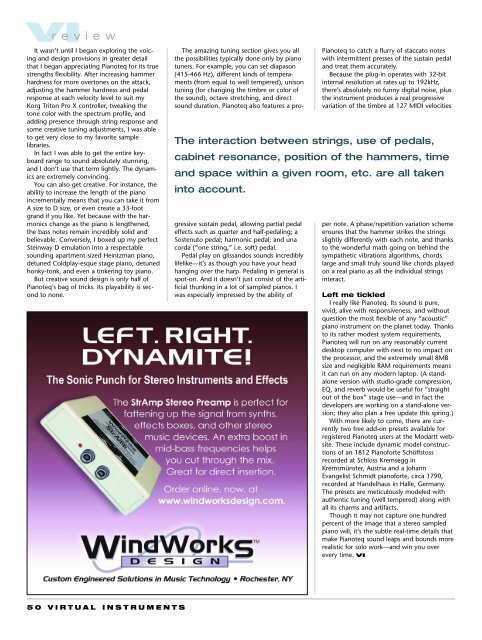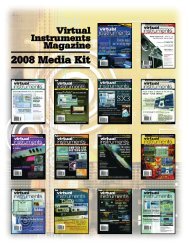Akai EWI 4000m Electric Wind Instrument Akai EWI 4000m Electric ...
Akai EWI 4000m Electric Wind Instrument Akai EWI 4000m Electric ...
Akai EWI 4000m Electric Wind Instrument Akai EWI 4000m Electric ...
You also want an ePaper? Increase the reach of your titles
YUMPU automatically turns print PDFs into web optimized ePapers that Google loves.
VI<br />
review<br />
It wasn’t until I began exploring the voicing<br />
and design provisions in greater detail<br />
that I began appreciating Pianoteq for its true<br />
strengths flexibility. After increasing hammer<br />
hardness for more overtones on the attack,<br />
adjusting the hammer hardness and pedal<br />
response at each velocity level to suit my<br />
Korg Triton Pro X controller, tweaking the<br />
tone color with the spectrum profile, and<br />
adding presence through string response and<br />
some creative tuning adjustments, I was able<br />
to get very close to my favorite sample<br />
libraries.<br />
In fact I was able to get the entire keyboard<br />
range to sound absolutely stunning,<br />
and I don’t use that term lightly. The dynamics<br />
are extremely convincing.<br />
You can also get creative. For instance, the<br />
ability to increase the length of the piano<br />
incrementally means that you can take it from<br />
A size to D size, or even create a 33-foot<br />
grand if you like. Yet because with the harmonics<br />
change as the piano is lengthened,<br />
the bass notes remain incredibly solid and<br />
believable. Conversely, I boxed up my perfect<br />
Steinway D emulation into a respectable<br />
sounding apartment-sized Heintzman piano,<br />
detuned Coldplay-esque stage piano, detuned<br />
honky-tonk, and even a tinkering toy piano.<br />
But creative sound design is only half of<br />
Pianoteq’s bag of tricks. Its playability is second<br />
to none.<br />
50 VIRTUAL INSTRUMENTS<br />
The amazing tuning section gives you all<br />
the possibilities typically done only by piano<br />
tuners. For example, you can set diapason<br />
(415-466 Hz), different kinds of temperaments<br />
(from equal to well tempered), unison<br />
tuning (for changing the timbre or color of<br />
the sound), octave stretching, and direct<br />
sound duration. Pianoteq also features a pro-<br />
gressive sustain pedal, allowing partial pedal<br />
effects such as quarter and half-pedaling; a<br />
Sostenuto pedal; harmonic pedal; and una<br />
corda (“one string,” i.e. soft) pedal.<br />
Pedal play on glissandos sounds incredibly<br />
lifelike—it’s as though you have your head<br />
hanging over the harp. Pedaling in general is<br />
spot-on. And it doesn’t just consist of the artificial<br />
thunking in a lot of sampled pianos. I<br />
was especially impressed by the ability of<br />
Pianoteq to catch a flurry of staccato notes<br />
with intermittent presses of the sustain pedal<br />
and treat them accurately.<br />
Because the plug-in operates with 32-bit<br />
internal resolution at rates up to 192kHz,<br />
there’s absolutely no funny digital noise, plus<br />
the instrument produces a real progressive<br />
variation of the timbre at 127 MIDI velocities<br />
The interaction between strings, use of pedals,<br />
cabinet resonance, position of the hammers, time<br />
and space within a given room, etc. are all taken<br />
into account.<br />
per note. A phase/repetition variation scheme<br />
ensures that the hammer strikes the strings<br />
slightly differently with each note, and thanks<br />
to the wonderful math going on behind the<br />
sympathetic vibrations algorithms, chords<br />
large and small truly sound like chords played<br />
on a real piano as all the individual strings<br />
interact.<br />
Left me tickled<br />
I really like Pianoteq. Its sound is pure,<br />
vivid, alive with responsiveness, and without<br />
question the most flexible of any “acoustic”<br />
piano instrument on the planet today. Thanks<br />
to its rather modest system requirements,<br />
Pianoteq will run on any reasonably current<br />
desktop computer with next to no impact on<br />
the processor, and the extremely small 8MB<br />
size and negligible RAM requirements means<br />
it can run on any modern laptop. (A standalone<br />
version with studio-grade compression,<br />
EQ, and reverb would be useful for “straight<br />
out of the box” stage use—and in fact the<br />
developers are working on a stand-alone version;<br />
they also plan a free update this spring.)<br />
With more likely to come, there are currently<br />
two free add-on presets available for<br />
registered Pianoteq users at the Modartt website.<br />
These include dynamic model constructions<br />
of an 1812 Pianoforte Schöffstoss<br />
recorded at Schloss Kremsegg in<br />
Kremsmünster, Austria and a Johann<br />
Evangelist Schmidt pianoforte, circa 1790,<br />
recorded at Handelhaus in Halle, Germany.<br />
The presets are meticulously modeled with<br />
authentic tuning (well tempered) along with<br />
all its charms and artifacts.<br />
Though it may not capture one hundred<br />
percent of the image that a stereo sampled<br />
piano will, it’s the subtle real-time details that<br />
make Pianoteq sound leaps and bounds more<br />
realistic for solo work—and win you over<br />
every time. VI



